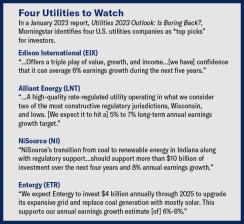“After a volatile stretch for utilities stocks, we expect a return to steady, fundamental growth.”
“We think utilities’ growth opportunities are better than the sector has had in many decades.”
For most institutional investors, these two sentences from a January 2023 Morningstar report — Utilities 2023 Outlook: Is Boring Back? — were among the most welcome insights from a solid source to grace the new year. And for good reasons.
Many institutional investors are longing for the pre-2020 days when they could rely on utilities to deliver consistent, drama-free returns and a healthy flow of dividend income. For decades, they depended on utilities’ resilience and stability in offering attractive returns in a variety of market conditions. The track record warranted this faith; U.S. utilities have returned an average 8.6% annually in the last 30 years, and posted double-digit returns in 18 of those years. Asset managers enjoyed the privilege of regarding the sector as benevolently boring — a precious characteristic that other equity categories sorely lacked.
That all blew up in early 2020. A rush of unwanted excitement began for utilities stocks, and for the last three years they’ve been more volatile than the market — and 30% more volatile than they’ve been in the previous 25 years. Despite the broader utility sector’s continued strong performance in recent years (it outperformed the market by 21 percentage points in 2022, for example), many institutional investors just badly want utilities to resume the quiet, steadfast role that’s long been essential to their long-term asset strategies — leaving those turbulent thrills to other sectors.

Growth without volatility may be back
These investors may be getting their wish. The Morningstar report argues that the utilities sector is not only primed to retake its long-held position as a solid equities performer without the instability seen since 2020, but also well-positioned to thrive and grow in the coming years. Analysis by Morningstar, and their subsidiary PitchBook, tracks every aspect of the public and private equity markets, and their report sums up the broad positives that generate this optimism:Utilities’ balance sheets are strong, dividends are well covered, regulation is improving, and environmental policy supports infrastructure growth. Investors who like boring should enjoy holding utilities in 2023.
Buying opportunities include utilities with stable long-term growth plans and still-robust dividend yields…We forecast 6% average annual EPS and dividend growth for U.S. utilities during the next three years.
…Aggressive environmental policymaking could push growth higher for some utilities… Best-in-class utilities could grow 8% or faster. This is the sector’s best growth outlook in decades, with the clean energy transition positioning utilities for strong growth for decades to come.
Institutional investors weary of the sector’s recent volatility should be heartened by this outlook. However, as a key tradeoff, most know that they must expect somewhat lower dividends from utilities stocks for at least the next few years. Due to rising interest rates and other factors examined in the Morningstar publication, the sector’s stock dividends have fallen sharply; in September 2022, in fact, bonds edged out utilities stocks in generating income the first time since 2008. While utilities equities are not likely to offer notably high dividends again anytime soon, Morningstar feels their growth potential outweighs this negative.

Why are utilities primed to thrive?
The report outlines why Morningstar believes the growth opportunities for utilities are better now than the sector has seen in more than 30 years, and several of these reasons are evident to most Americans. Energy costs, power reliability, and environmental measures are receiving greater attention in Washington, D.C. and in many states than they have since perhaps the early 1970s. Growing pressures to advance the technologies in cleaner and renewable energy sources are spurring greater investment. Additionally, escalating tensions with Russia, China and other geo-political entities are emphasizing just how vital the resilience of the electrical grid infrastructure is to U.S. national security. And evolving ESG standards are compelling more corporations to reduce carbon emissions.In short, forces emanating everywhere from consumers’ wallets to corporate board rooms, from the Pentagon to the U.N., are aligning to markedly increase investment in U.S. utilities.
Hard figures bear this out. The report states 40 largest utilities in the U.S. had a combined investment of $144 billion in 2021, adjusted for inflation, and Morningstar estimated that this increased to more than $150 billion in 2022 — well above the inflation-adjusted five-year annual average of $136 billion. As efforts to increase clean energy and upgrade infrastructure gain momentum, Morningstar estimates these companies will spend nearly $500 billion over the next three years.
Capital investment is power hungry
It’s no surprise that the majority of investment dollars is focusing on electricity. As inflation and conflict continue to push retail energy prices skyward in many areas of the planet, and a 40-year high in U.S. inflation is causing Americans to sacrifice more discretionary pleasures to keep their homes lit and comfortable, utilities companies are well aware that boosting their capabilities and efficiency in power generation must be a top priority. Their spending reflects this reality, as the Morningstar report relays:The Edison Electric Institute, an association representing investor-owned electric utilities, estimates that its member utilities will allocate more than three fourths of their capital investments to electric generation, distribution, and transmission, with the remaining capital investment going to gas-related infrastructure and regulatory compliance. Power generation represents 24% of EEI’s capital investment estimate, most of which we expect will go toward clean energy projects.
The logical next question is, on which specific technologies and areas of innovation are U.S. utilities focusing the lion’s share of their power-related investments? There are several stars and top contenders in their capital investment growth pipeline, and most institutional investors are already dedicating special attention to their likely development paths through the mid 2020s and beyond. In the near term, however, the hottest energy zones are clear; the Morningstar report lists the top five trends to watch in 2023 as solar, electricity demand, hydrogen, offshore wind, and nuclear energy.
Solar will shine
Supply chain issues and tariff uncertainties impeded investments in solar energy in 2022, causing it to lag further behind wind in new renewable energy capacity growth. But Morningstar expects this year will be quite different. The report states, “With solar tariff clarity and incentives from the U.S. Inflation Reduction Act, we expect solar will be the dominant renewable energy technology choice in 2023 and beyond as a result of improving economics, favorable tax policy, and greater solar system efficiencies.”
Electricity demand to surge
Morningstar expects electricity demand to grow faster in the 2020s than it has in the last two decades, mainly spurred by the increase in adoption of electric vehicles. With multiple national and state-level plans and policies coalescing to encourage EV use and build the charging infrastructure it requires, the road is clearing for all-electric cars and trucks to gain widespread use in the coming years. Investment opportunities in related areas should also abound. “We think building the infrastructure to support in-home and commercial chargers is one of utilities’ biggest long-term growth opportunities in addition to renewable development,” Morningstar reports.
Hydrogen may emerge
“Hydrogen projects aren’t a near-term growth driver for utilities, but they could become a material part of utilities’ post-2026 capital investment plan,” according to the report. It notes that many utilities have announced their intentions to invest in hydrogen initiatives to augment renewable energy, natural gas, and nuclear power. For example, Morningstar writes, “As part of the 2021 infrastructure bill, the U.S. Department of Energy is collecting proposals to fund the development of 6–10 regional renewable energy-fueled hydrogen hubs. Many utilities are part of consortiums that are submitting proposals.”
Offshore wind may dwindle
While U.S. investment in offshore wind projects has increased briskly in recent years, following Europe’s lead, rising costs and inflationary pressures are causing several states and utilities to rethink their plans, Morningstar reports. Offshore wind still has a vital role in meeting the nation’s energy requirements, and some large projects might proceed, but institutional investors with allocations to renewable energy should watch for signs of drag from this specific segment.
Nuclear to stay sidelined
“We think nuclear will have to play a role in any net-zero 2050 emissions plan…However, new nuclear will remain on the sidelines in the near term, with renewable energy continuing to be the primary method of reducing power generation carbon emissions,” Morningstar writes.
Certainly, December’s much-heralded breakthrough in achieving commercially-viable nuclear fusion — when scientists at Lawrence Livermore National Laboratory in California made history by generating a net surplus of energy from a fusion experiment for the first time — aroused the long-held dream of creating abundant, clean nuclear energy. But the reality is still a distant prospect, and even many nuclear optimists doubt that fusion will be a feasible energy source before the late 2030s.

What could derail utilities’ growth?
Morningstar’s report also notes the most prominent risks institutional investors need to watch for in the U.S. utilities sector — citing several that could fuel continued volatility, erode valuations, and hinder stock performance, if realized. Most stem from impactful changes that have occurred in the utilities sector since 2020, as well as the stark economic changes at the national and global level.Historically low interest rates allowed utilities stocks to pay high dividends over the last decade, and those lofty yield premiums inflated utilities’ valuations. But a surge in inflation and rising interest rates quickly soured the friendly environment for utilities — and triggered a jump in consumer energy prices that brought new scrutiny and headaches.
Morningstar cautions that the challenges created by inflation, recent increases in energy costs, and high interest rates could worsen and overwhelm the positive forces in the utilities sector, noting:
Inflation, including higher energy prices, will raise customer bills and could force utilities to re-evaluate their growth plans…[However, a] natural gas price selloff could bring relief to customer bills and ease regulatory tension.
…The rise in bond yields erased the yield premium for utilities’ valuations to record highs. Less attractive yields will weigh on utilities’ returns, making company fundamentals more important.
…Without the dividend yield premium as a backstop, utilities stocks face valuation risk…We think the only factor stopping a significant revaluation of the sector is utilities’ historically attractive growth prospects.
But valuations are strong, and so is the forecast
While utilities stocks have seen decreased valuations since late 2021, Morningstar feels this was a needed correction from their inflated pre-2021 figures and their valuations are now fair on median basis. This is notable when you consider that utilities’ valuations remain historically rich, significantly higher than their pre-2008 average, and above the current market. As of January 19, 2023, the Morningstar U.S. Utilities Index had a price/earnings multiple of 22 while the Morningstar U.S. Market Index P/E was 19.Achieving reasonable yet strong valuations is just one of the several reasons Morningstar believes that the utilities sector is more likely to return to steady — and refreshingly boring — growth than it is to be derailed by the risks and challenges it faces. And the report also makes it clear that these fair valuations could indeed resume an upward journey that, this time, would be well earned: “If utilities can execute their attractive long-term growth plans, we think they deserve valuations higher than their pre-2008 levels even if interest rates plateau at current levels… Utilities’ long-term growth outlook is the key issue to watch in 2023.”
Learn more about investment opportunities in utilities stocks.






